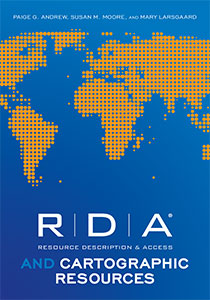
RDA and Cartographic Resources
For UK or EU purchases, contact Facet Publishing to order. For all other purchases outside the United States, please consult our International Orders page.
Primary tabs
You don't need to be an ALA Member to purchase from the ALA Store, but you'll be asked to create an online account/profile during the checkout to proceed. This Web Account is for both Members and non-Members.
If you are Tax-Exempt, please verify that your account is currently set up as exempt before placing your order, as our new fulfillment center will need current documentation. Learn how to verify here.
- Description
- Table of Contents
- About the authors
- Reviews
As the cataloging universe moves ever deeper into the era of RDA: Resource Description and Access, specialist catalogers need information on managing the materials in their areas of responsibility. In this manual, three expert catalogers offer a summary and overview of how to catalog cartographic resources using the new standard. Through abundant examples and sample records to illustrate the work, the authors
- Take a close look at what remains familiar from AACR2, and what is new and different in RDA
- Offer guidance for creating authorized geographic subject headings using Functional Requirements for Bibliographic Resources (FRBR) and Functional Requirements for Authority Data (FRAD)
- Present a detailed examination of geographic subject headings and subdivisions
Designed for both practicing map catalogers and catalogers new to cartographic resources, this volume will be a one-stop resource for all catalogers of cartographic materials looking to understand the differences between cataloging using AACR2 and cataloging using RDA.
Contents
List of Figures
- The Past is Prologue
- RDA and FRBR Entities as Applied to Cartographic Resources: An Overview
- Comparing Standards: Continuing, Different, and Added Practices
- Navigating RDA to Describe Cartographic Resource Elements
- Cartographic Resources Cataloging: Moving Forward
Postscript
Appendixes
- Image of Damietta Sheet from the Egpyt 1:100,000 Series
- Map Record Example Showing FRBR Relationship Entities
- RDA Checklist for Descriptive Elements
- Examples of Correct Scale and Coordinates Notation in the 255 Field with Matching Examples in the 034 Field under AACR2 and RDA
- 33X Content, Media, and Carrier Terms Examples Based on Different Kinds of Cartographic Resources
- Digital Resources Notes: Comparing RDA Number with MARC Field Number
- Sample Records for Different Cartographic Resources Types
About the AuthorsIndex
Paige G. Andrew
Paige G. Andrew is the Maps Cataloging Librarian at the Pennsylvania State University Libraries, holding the rank of Full Librarian. He participates in three of the Library of Congress Program for Cooperative Cataloging (PCC) programs: BIBCO, NACO, and SACO. He has published articles on the bibliographic control of cartographic materials and related topics in professional journals such as Cataloging and Classification Quarterly, and authored Cataloging Sheet Maps: The Basics (Haworth Information Press, 2003). He co-edited, with Mary Lynette Larsgaard, Maps and Related Cartographic Materials: Cataloging, Classification, and Bibliographic Control (Haworth Information Press, 1999), and with Larsgaard is co-founder of and continues as co-editor of the Journal of Map and Geography Libraries: Advances in Geospatial Information, Collections and Archives. He has served his profession as an officer and as chair of many committees, including those of the Special Libraries Association, the American Library Association, and several others. He continues to share his expertise in map cataloging through workshops given at conferences and individual institutions as well as through formal presentations. He was the recipient of the 2009 Nancy B. Olson Award for significant contributions to audiovisual cataloging by OLAC (Online Audiovisual Catalogers, Inc.).
Susan M. Moore
Susan M. Moore is a Catalog Librarian and Bibliographer at the Rod Library at the University of Northern Iowa in Cedar Falls, Iowa. She has been teaching map cataloging workshops since 1999. She is a member of the Map and Geospatial Information Round (MAGIRT) of the American Library Association, currently chairs the MAGIRT Committee on Cataloging and Classification and is the MAGIRT liaison to the Library of Congress' MARC Advisory Committee. She recently received the MAGIRT Honors Award in 2009.
Mary Lynette Larsgaard
Mary Lynette Larsgaard (1946-2017) was Librarian Emeritus of the UCSB Libraries, and was also formerly Assistant Head and then Head of the Map and Imagery Laboratory, Davidson Library, University of California at Santa Barbara. She published extensively in the field of cartographic resources in libraries, most notably Map Librarianship: An Introduction, now in its third edition. Her specialties were cataloging/metadata creation, and collection development and other aspects of twentieth-century and more recent topographic and geologic maps.
"Provides solid guidance for map cataloguers of all levels … clearly written, detailed and easy to use."
— Journal of The Australian and New Zealand Map Society Inc.
"This manual was written by three noted experts—Andrew of Penn State University, Moore of the University of Northern Iowa, and Larsgaard, the longtime guru of map cataloging who is now librarian emeritus of the University of California Santa Barbara—lending it a kind of authority that is hard to match."
— Technicalities
"Both readable and useful. The chapters follow the normal flow of the map cataloging process and offer clear examples and descriptions of rule interpretations. The text, tables, and illustrations explain the process so that a cataloger, whether beginner or expert, can work with confidence ... I believe that this book will become an essential text for map catalogers and for anyone who wants to understand RDA as it pertains to the maps format."
— Technical Services Quarterly


